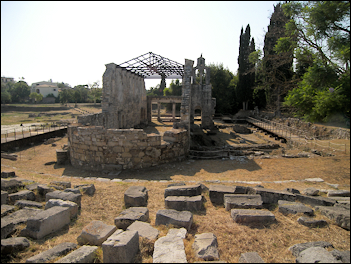EARLY CHRISTIANITY IN EUROPE
Palaeo Christian Church in the
Old Town of Corfu, Greece Michael J. McClymond wrote in the “Worldmark Encyclopedia of Religious Practices”:During the medieval period Christianity grew and flourished through the efforts of monks, nuns, and members of newly established religious orders. The original Christian monks, led by Anthony (251–356), went into the Egyptian desert to pray and lead simple and largely solitary lives. The colder climate of Europe forced monks there to erect buildings and engage in farming and craftwork to support themselves. [Source: Michael J. McClymond, “Worldmark Encyclopedia of Religious Practices”, 2000s, Encyclopedia.com]
In European monasticism, led by Benedict (c. 480–c. 545), male monks and female nuns served the needs of the communities around them. In their work of copying manuscripts, monks preserved both pagan and Christian traditions and so insured that civilization would continue through the Dark Ages of the 800s and 900s. Patrick (c. 390–c. 460), a missionary from Britain to Ireland, was influential in the westward spread of Christianity.
Many reformers of the Middle Ages, who called the church back to its ancient faith and fervor, arose from the ranks of the monks. They included Bernard of Clairvaux (1090–1153) and Francis of Assisi (1181/2–1226). The greatest of the medieval theologians were all associated with monastic or religious orders. Anselm of Canterbury (1033–1109) was head of a Benedictine community, Thomas Aquinas (1225–74) was a Dominican, and both Bonaventure (1217–74) and Duns Scotus (1266–1308) were Franciscans.
Beginning in the eleventh and twelfth centuries, universities were founded throughout Europe as centers for training in theology, medicine, law, and the liberal arts. In its Scholastic form theology played a unifying role as the "the queen of the sciences." Though women's roles were limited, the church's literature was enriched by the writings of great women mystics, including Hildegard of Bingen (1098–1179) and Julian of Norwich (mid-1300s–early 1400s).
Christianity and the Roman Empire, See Separate articles on CONSTANTINE, CHRISTIANITY IN THE ROMAN EMPIRE and PERSECUTION OF CHRISTIANS.
Websites and Resources: Early Christianity: “Egeria's Description of the Liturgical Year in Jerusalem” users.ox.ac.uk ; PBS Frontline, From Jesus to Christ, The First Christians pbs.org ; Elaine Pagels website elaine-pagels.com ; Sacred Texts website sacred-texts.com ; Guide to Early Church Documents iclnet.org; Early Christian Writing earlychristianwritings.com ; Internet Ancient History Sourcebook: Christian Origins sourcebooks.fordham.edu ; Christianity BBC on Christianity bbc.co.uk/religion/religions/christianity ; Candida Moss at the Daily Beast Daily Beast ; Christian Classics Ethereal Library www.ccel.org
Book: "Barbarian Conversion, From Paganism to Christianity” by Richard Fletcher (Henry Holt, 1998). Fletcher is a University of York Professor. The book chronicles how Ireland, Britain, Northern Gaul, Germany, Scandinavia and most of Central Europe accepted Christianity.
Spread of Christianity in Europe
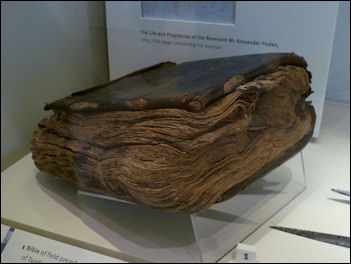
Covenanter BibleInitially, the Christianized Romans had no desire to spread Christianity beyond their borders. Around the time the Roman Empire collapsed Christianity began spreading throughout Europe, primarily through the efforts of monks and missionaries.
The process of the spread of Christianity took place slowly. It took time for the religion to reach different places and then it took time for it to be embraced by local people. In Europe, Christianity began as an urban religion. It spread to wealthy landowners and then to rural tenant farmers. Many early Christians hedged their bets and worshiped their old pagan gods after accepting Christianity. Richard Fletcher, a University of York professor, "In Denmark and in Sweden little soapstone molds have been found for simultaneous casting of the cross of Christ and the hammer of Thor."
Missionaries focused their attention on noblemen. The belief was that of leader were converted their people would follow. Attention was also directed at noblewomen. Several Christian queens converted their pagan king husbands. "Christianity became an inseparable component of the aristocratic identity." Many kings were hesitant about converting to Christianity because they were worried what their noblemen would take it the wrong way. The Russian Svyatoslav wrote, "I'm afraid my retainers would laugh at me."
Early Christian figures included Count Wilfred the Hairy of Barcelona; Eric Bloodaxe, the last Scandinavian ruler of Britain, and Nicholas Breakspeare, the only Englishman ever to become pope. On other early Christian leaders in Europe, historian Richard Fletcher wrote: "Converting to the religion after a fall from his horse in about 1114, Norbert adopted a regime of ferocious asterism (it killed his first three disciples)...Wulfstan was a realist who did not ask the impossible of his clergy. They must shave regularly, must not bring their weapons to church, must try to keep out of fights and must not perform in taverns as 'ale minstrels.'"
Christian Missionaries and the Spread of Christianity
Missionaries played a greater role in Christianity than any other religion. Unlike Muslims who conquered by the sword, Christians relied on missionaries to spread the word on the fringes of Europe. Over time reclusive monks and pilgrims became missionaries and monasteries were established that became centers of learning and of Christian preaching. As early as the second century a missionary college was founded in Alexandria and another in Constantinople in 404.
In A.D. 410 Christianity reached Britain from Gaul. The Celtic church was driven west into Wales and Ireland by the Anglo-Saxon invasion. Then from Ireland Christianity was brought back to the European continent — in Holland, Germany and Switzerland — by the Irish abbot St. Columbanus. Lesser missionaries spread the word across the continent: in the high mountains of Switzerland, in the Rhine Valley, in the Swedish forests, and in frigid Russia. Missionaries often had their biggest successes converting chiefs and warlords in wild tribal areas of Europe by telling them that Christianity would bring them "victory, wide dominion, fame and riches." These warlords in turn converted the members of their tribes.
Michael J. McClymond wrote in the “Worldmark Encyclopedia of Religious Practices”: The expansion of Christianity from its homeland in Palestine to the rest of the world has been a continual process of translation. Linguists have rendered the Bible into thousands of languages, each with a different word for God and a different set of cultural and religious assumptions. Christianity is thus a religion of cultural adaptation, and the faith must be "incarnated" in each new setting. Throughout history missionaries went into new territories because they were convinced that non-Christians were doomed to hell. The early church writer Cyprian coined the phrase extra ecclesiam nulla salus (there is no salvation outside the church). [Source: Michael J. McClymond, “Worldmark Encyclopedia of Religious Practices”, 2000s, Encyclopedia.com]
Missionary methods included: 1) Monastic (evangelization by example) and 2) Content (demonstrating the impotence of paganism and superiority of Christianity). 3) Theology was kept to a minimum. The role of secular princes was important — conversion from top down. Other elements included works of charity, social betterment, ending feuds, moral example, higher civilization, introduction of new methods of farming and establishing, close personal bonds By the end of the 12th century Christianity had triumphed over paganism in most of Europe — Christendom and Europe became synonymous. [Source: Carl A. Volz, web.archive.org, martin.luthersem.edu]
Famous Missionaries and Early Christian Figures
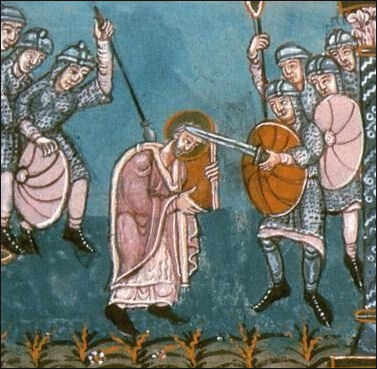
St. Boniface Important early missionaries: St. Patrick, St. Columba, Gregory the Great (who sent missionaries to Britain), St. Augustine of Canterbury, St. Boniface, Anskar ("the Apostle of the North"), Bebe (the learned and venerable 7th century author of an early Bible), Photius ("perhaps the most encyclopedic intellect ever to flourish in Byzantium”), the Slavic brothers St. Cyril and St. Methodius.
Pope Gregory the Great (A.D. 590-604) sent 40 monks led by Augustine to Great Britain in A.D. 596. Around the time the Lombards ravaged Rome and Byzantium failed to defend Rome. The defense of Rome was left to the Pope. Pope Gregory made peace with Lombards. The Exarchate of Ravenna in Italy was the Byzantine emperor's agent Gregory wrote “A Pastoral Rule [Source: Carl A. Volz, web.archive.org, martin.luthersem.edu]
Saint Boniface (675-755) was born in England and ordained as a priest after joining a Benedictine order. He is credited with helping to bring Christianity to Germany and unifying the tribes there. His most courageous act was destroying a sacred oak tree worshiped by the Germanic tribes at the home of their main god, Thor. After that Boniface won many converts to Christianity and was able to found many churches in Germany and establish himself as the archbishop of Mainz in A.D. 748. He was killed by pagans while doing missionary work in Frisia. He now is often referred to as the “patron” or “apostle” of Germany.
In Eastern Europe Cyril and Methodius (mid-800s) went from Constantinople to convert the Slavs. In the 800s Bulgarian leaders considered affiliation with Rome but were turned off by the insistence on papal authority, priestly celibacy, and Latin in worship, and thus turned instead toward Constantinople. Russian Orthodoxy, which began with the baptism of Prince Vladimir in 988, flourished in the region of Kiev until the invasion of the Mongols in 1240. It was took almost three centuries for Russian Christians to fully regained their political and religious control. Moscow displaced Kiev as Russia's religious and cultural center. [Source: Michael J. McClymond, “Worldmark Encyclopedia of Religious Practices”, 2000s, Encyclopedia.com]
Arrival of Christianity in Britain
In A.D. 410, Christianity reached Britain from Gaul (France). The Celtic church was driven west into Wales and Ireland by the Anglo-Saxon invasion. Then from Ireland Christianity went back again to Europe — Holland, Germany and Switzerland — thanks to by St. Columban (543– 615). At that time population of England was mainly Celtic, with some Romans.
In 563, Columban traveled to Scotland with twelve companions (said to include Odran of Iona) in a wicker currach covered with leather. He made it to Lindisfarne. In 1997, a group of students replicated the 135 mile voyage of St. Columban from Ireland to the island of Iona in a traditional curragh, made of oak, pine and tarred canvas. Aided by small sails and wind, the 14 students rowed the distance in six days. The 38-foot-long curragh was the longest ever made
Augustine of Canterbury was a Benedictine monk sent by Pope Gregory to England in A.D. 597 to convert King Ethlebert of Kent and establish England's first Christian church at Canterbury. The abbey that became Canterbury Cathedral was founded soon after his arrival. King Ethelbert and Christian Queen Bertha converted to Christianity, they say, on Christmas day A.D. 597 with 10,000 followers. There was regular correspondence between Augustine and Gregory on pagan practices. Gregory the Great sent Augustine to Britain after seeing English slave boys in a Roman market he said. "They are Angles, but angels."
The Christian mission of St. Augustine was set up on the island of Thanet Augustine in the 6th century. On A.D. 630 Saint Edwin (Edwin of Northumbria) converted to Christianity. York became a major Christian center. An influential Irish monk named Saint Aiden founded a monastery in 635 Lindisfare, a three-x- two- mile holy island off the coast of eastern England. Saint Cuthbert set up a hermit cell on nearby Farne Island in 676. After numerous miracles were attributed his dead body, Lindisfare and Frane Island became popular pilgrimage destinations. Cuthbert was a shepherd who became a bishop. He protected birds and animals and died in 687. By A.D. 700 Britain nominally Christian.
St. Patrick

St. Patrick in the
Nuremberg chroniclesSt. Patrick (Patrick of Armagh) converted Ireland to Christianity, by some estimates, between 457 and 492. In his book “Barbarian Conversion, From Paganism to Christianity”, Richard Fletcher wrote he appears to have been "the first person in Christian history to accept the Scriptural injunctions literally, to grasp the teaching all nation meant teaching even barbarians. The dates of St. Patricks’ birth and death are not known. Most of what is know is about St. Patrick comes from “Confessions”, a short memoir said to have been before he died in the late 400s.
St. Patrick was born somewhere in England. No one knows exactly where he was born and when, although some scholars think it was round 385. He was the son of a fairly well-to-do church deacon and grandson of an early Roman Christian priest, St. Patrick was brought up in relative comfort. He said he was raised as a Christian but admitted in “Confessions” he "knew no the true God."
St. Patrick was raised in Britain at a time when it part of the Roman Empire, and the empire was in a state of decline. Without the protection of the Roman army, Britain was vulnerable to attacks from Irish pirates. During one such raid, St. Patrick and a thousands of others were captured and taken back to Ireland as slaves. Unlike Britain, which had roads, laws and civilized culture brought by the Romans, Ireland was a wild place ruled warlords and Druid priests, who performed human sacrifices, it is said.
St. Patrick spent about six years in Ireland during his first stint there. He was purchased by a Druid and spent much of his time, hungry and half naked herding animals. It was in the wilderness, he experienced his religious conversion. In “Confessions” he wrote, "The love of God and His fear grew in me more and more, as did the faith, and my soul was roused, so that, in a single day, I have said as many as a hundred prayers, and in the night, nearly the same....I prayed in the in woods and on the mountain, even before dawn. I felt no hurt from the snow or ice or rain."
Afterwards St. Patrick escaped and hiked 200 miles to a seaport and was able to convince a ship captain to take him to Gaul (France) even though he had no money or other way to pay for his passage. Patrick later made his way back to his family in England but the details are sketchy. He then trained to be a missionary, some say under St. Germaine, with the goal of returning to Ireland and converted the pagan masses there.
St. Patrick Coverts Ireland
A few missionaries had preached to Ireland before St. Patrick but the had little success, and some were killed. Christianity threatened the power of the warlords, kings and the Druids. St. Patrick had an advantage that his predecessor's didn't have. He had spent six years in Ireland before and was familiar with Irish ways but he still was under constant threat of being robbed or attacked by bandits or enemies of the kings whose territory he was traveling in.
In St. Patrick's time, Ireland composed of a number of small kingdoms, called twatha, ruled by petty kings and warlords, who were often battled one another. They in turn answered to kings of the five provinces and a single high king. seated in Tara, then the capital of Ireland. St. Patrick believed that the key to success was converting the petty kings so they could both protect him and spread the word to others. St. Patrick was not above using bribes. "I spent money for your sake in order that they might let me enter," he wrote to his superiors in “Confessions”. "I made presents to the kings, not to mention the price I paid to their sons who escorted me."
St. Patrick is credited with planting the seed of Christianity among the Irish aristocracy and they in turned spread the religion to their peasant subjects. St. Patrick wasn't as successful as he would have liked converting the kings, because they had too much to lose by converting, but he was often tolerated in their courts and had better success converting relatives of the kings, especially younger siblings who were often left out of their father’s inheritance.
Thomas Cahill, author of “How the Irish Saved Civilization”, told CNN, "The Christianity that Patrick planted in Ireland was really of a unique kind, in the sense that he left behind all those dark, as meditations on human sinfulness that were favorites of the fathers of the Church, and instead he concentrated on the goodness of creation....The Irish were already very mystical. They believed that the world was a magical place, and he built on that rather than on this human sinfulness theme, and as a result, early Irish Christianity was extremely celebratory of the world, of the wrath, of matter, of human experience, of the human body...It gets off the ground very quickly in this kind of dance of happiness and joy which is very unlike the sound of earlier Christianity."
King Clovis and the Conversion of Europe to Christianity

spread of Christianity, dark blue to AD 325, light blue to 600
Christianity took a circuitous route to Europe via Ireland of all places. St. Patrick worked hard in the 5th century to make the religion take hold in Ireland. His style of Christianity took hold in the continent, where the religion had been present since Roman times. The first churches were founded in France around A.D. 250. The first Benediction monasteries opened in A.D. 630.
King Clovis (466-511) is considered by many French to be the father of France and the person who brought Christianity there to stay. Also known as Chlodwig, Ludwig and Louis and considered the first French king (and even the first Frenchman) because he was a Christian, he made Paris his capital (briefly when Paris was only a village) and he drank champagne. The French monarchs that followed regarded Clovis as their spiritual forefather. That is one reason why 16 kings called themselves Louis, were using an updated version of the name Clovis.
Clovis was a pagan during his early years of conquest and rise to power even though his wife was a Christian and his children were raised in the faith, which was already practiced by many people in his kingdom. According to legend Clovis became a Christian in A.D. 496 (more likely 499 and possibly as late as 506) to fulfill a vow in which he said would give up his paganism if the Christian God helped him win an important battle against the Alamannu, a rival Germanic tribe. Clovis won the battle and he and a few thousand of his men were baptized at Reims (where a famous cathedral was later built). His conversion allowed a "barbarian" Frank to rule Gaul with the "sword of the true faith." After he converted to Christianity he defeated the Aryan Burundians (500) and Visigoths at Voullié (507) and aligned France with the Catholic Church and the Papal states by the accepting the belief that God and Jesus Christ shared the same substance.
After Clovis and the Franks (Merovingian Franks) converted to Christianity, Christianity expanded under the aegis of secular rulers . But Gregory of Tours (d. 590) in the "History of the Franks", described how the Frankish church deteriorated. In A.D. 574,St. Columban arrived in Burgundy with a shipload of Irish monks and re-energized Christianity in France and brought the religion to Belgium, Holland and the coasts of North Sea. Willibrord — the "Apostle of Frisia" — arrived on the scene in A.D. 690 and inaugurated an alliance between the papacy and Anglo-Saxon mission, which worked to combine the authority of the Roman See with the continental church. [Source: Carl A. Volz, web.archive.org, martin.luthersem.edu]
Europe Becomes Fully Christianized
Pepin I, the father of Charlemagne, became king of the Franks in 751. He inaugurated a two centuries Carolingian dynasty in Europe which also dominated the church. St. Boniface was very active and influential. Christopher Dawson wrote: "It was the Anglo-Saxon monks and above all St. Boniface who first realized that union of Teutonic initiative and Latin order which is the source of the whole medieval development of culture."
The Coronation of Charlemagne on Christmas day in 800 by the Pope Leo III marked beginning of Holy Roman Empire and the unification of church and state in Europe. The Christian conversion process was relatively peaceful until Charlemagne decided to covert the Saxons. The brutal campaign became a "blueprint for the Crusades."
Christianity was dealt some setbacks. Islam made its way into Spain, southern Italy and Sicily. Rome was plundered by Muslim in 846. Genghis Khan entered Hungary Poland and Russia. Tamerlane destroyed Christian settlement in Asia Minor. The church was also weakened by divisions within. There were acrimonious doctrine disputes over Jesus' divinity, the alliance of church and state, the dual nature of Christ, and giving of sacraments by sinful priests. These division were exacerbated by regional rivalries.
There were also doctrinal issues between the Rome-based Western Church and Constantinople-based Eastern Church. Differences grew, particularly over the Nicene Creed (whose main point is that Jesus is "of the same substance" as God rather than a separate being). Finally in 1054, the two churches formally split, resulting in two distinct churches: the Roman Catholic Church and the Eastern Orthodox Church. After that the popes in Rome vied for secular power with the princes and kings of Europe. By 926, European states had loosely joined together as the Holy Roman Empire, with the pope in Rome as the spiritual head. The pope would in turn make one of the many princes in Europe the emperor. This system remained in place until 1806 when Napoleon changed it. Over the centuries there continual competition between the popes and the princes for power.
The Greek Church and Latin Church competed for several centuries. Five equal patriarchs shared power for a period of time. There were struggles between the kings and emperors over the right to have some say in the appointment of bishops.Even so, by 1200 nearly all of Europe was Christian
See Separate Article: Catholic-Orthodox Split: Friction, Disputes, Iconoclasm africame.factsanddetails.com
First Domed Churches
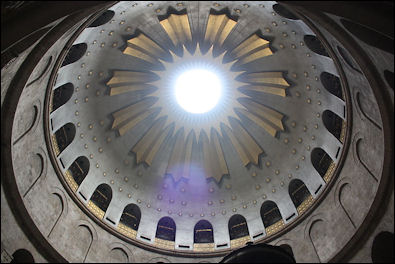
Dome over the Tomb of Jesus
at the Church of the Holy SepulchreRoman and Greek temples were primarily homes of the gods. A church was different in that it was both a house of god and assembly place for worshipers. The first churches used domes like those on pagan Roman temples such as the Parthenon to create a space for the worshipped; the altar was placed at one end.
The best example of this kind of church, or basilica, is Hagia Sophia in Istanbul (A.D. 532) and Saint Costanza in Rome (A.D. 350). The next advancement was creating a long church with a rectangular plan, instead of round one, and a system or arches and columns to support it that created a long nave to accommodate the worshippers. The original St. Peters (begun A.D. 333) in Rome and S. Apollinare (A.D. 549) in Ravenna are built in this fashion.
In Roman times basilicas were often meeting halls or law courts. Domes were first built over Roman baths, and in the Christian church they later became associates with baptisteries, or places where one gets baptized.
Haghia Sophia
Hagia Sophia in Istanbul (Constantinople) was the largest religious building in the world until St. Peters was completed in Rome. But what was even more amazing was that it was finished 1000 years before St. Peters was even started. Also known as Saint Sophia and Aya Sofya, it was described soon after it was completed by the historian Procopius wrote as “a most glorious spectacle, extraordinary to those who behold it and altogether incredible to those who are told of it. It is distinguished by indescribable beauty, excelling both in is size and the harmonies of its measures.”
Haghia Sophia is comprised of a large dome attached to half domes and semicircular niches. The rectangular basilica measures 230 feet by 250 feet and the dome is 180 feet above the ground and 100 feet across. Its interior spaciousness is created by the arrangement of arches, half domes and 40 stone ribs. Light enters through 40 windows and is focused on the emblematic sun at the dome’s center. There are also great columns and pillars, intricately designed ceramic tiles and some of the world’s most admired mosaics.
"Haghia Sophia" is Greek for “Holy Wisdom.” It is an awe-inspiring site today, but just imagine what it must have been like for people who witnessed it when it was finished in A.D. 536 and there was nothing even remotely like it in rest of the world. Byzantine Emperor Justinian supposedly spent 320,000 pounds of gold to build it and upon seeing the completed product for the first time he exclaimed "O Solomon I have surpassed thee!"
The plans for the church, surprisingly, were drawn up in less than six weeks by an architect named Athememius, who also had the distinction of being the first person to draw an ellipse with a string tied around two fixed points. The architectural advancement Athememius devised that made the building of the great church possible was the balancing of the massive 184-foot-high, 252-foot-long and 234-foot-wide dome on top of a square. Before that domes were built on set of columns arranged in a circle, a design much weaker structurally than a square.
To speed up construction the 5,000 men building one side of the church were pitted against the 5,000 men on other side. When the church was finished five years, ten months and four days later a huge celebration was held in which a thousand oxen, six thousand sheep, six hundred stags, one thousand pigs and ten thousand chickens and fowl were served up.
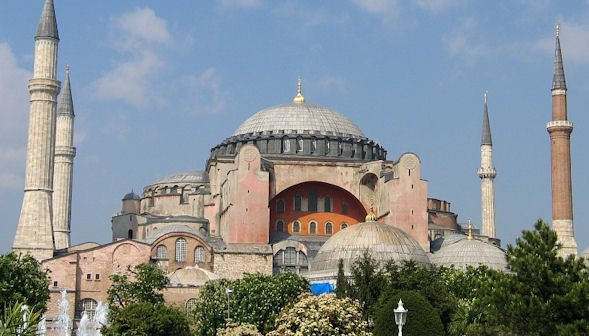
Hagia Sophia, now a mosque with minarets
Medieval Churches
In the Middle Ages, churches were important gathering places. Town meetings were usually held inside churches and moneychangers often greeted their customers on the square in front of the church. The churches themselves were cold and dark and there often no chairs or pews, only a straw covered floor to sit on. Worshippers often brought hand warmers and cushions when they attended mass. ["Life in a Medieval City" by Joseph and Frances Gies, Harper Perennial]
The first organs looked like giant accordions and the first pipe organ was built in Winchester Cathedral in A.D. 980. it had over 400 pipes and the keys were so heavy they had to be played with a clenched fist. ["Life in a Medieval City" by Joseph and Frances Gies, Harper Perennial]
Sermons usually lasted for a about half an hour. They were supposed to be delivered in Latin, but often the priest slipped into the vernacular because most worshippers did not understand Latin. The sermon was typically centered around a biblical episode or a story with a theme or moral. The priest offered communion to the people at the front altar with his back turned to them. ["Life in a Medieval City" by Joseph and Frances Gies, Harper Perennial]
Romanesque, Byzantine and medieval churches were often dark and gloomy places. Golden mosaics and bright-colored frescoes were regarded as a way of bringing light into the church. A flabellum was "a liturgical fan used to keep the flies away from the priest when saying mass."
Image Sources: Wikimedia Commons
Text Sources: Internet Ancient History Sourcebook: Christian Origins sourcebooks.fordham.edu “World Religions” edited by Geoffrey Parrinder (Facts on File); “ Encyclopedia of the World’s Religions” edited by R.C. Zaehner (Barnes & Noble Books, 1959); King James Version of the Bible, gutenberg.org; New International Version (NIV) of The Bible, biblegateway.com; Christian Classics Ethereal Library (CCEL) ccel.org , Frontline, PBS, Wikipedia, BBC, National Geographic, New York Times, Washington Post, Los Angeles Times, Smithsonian magazine, The New Yorker, Time, Live Science, Encyclopedia.com, Archaeology magazine, Reuters, Associated Press, Business Insider, AFP, Library of Congress, Lonely Planet Guides, Compton’s Encyclopedia and various books and other publications.
Last updated March 2024

